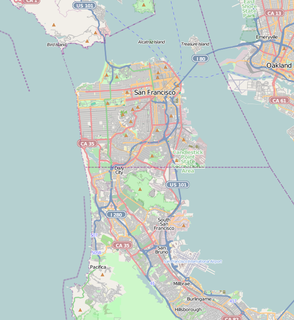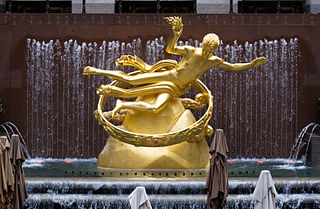
San Pedro is a community within the city of Los Angeles, California. Formerly a separate city, it consolidated with Los Angeles in 1909. The Port of Los Angeles, a major international seaport, is partially located within San Pedro. The district has grown from being dominated by the fishing industry, to a working-class community within the city of Los Angeles, to a rapidly gentrifying community.

The Drum Barracks, also known as Camp Drum and the Drum Barracks Civil War Museum, is the last remaining original American Civil War era military facility in the Los Angeles area. Located in the Wilmington section of Los Angeles, near the Port of Los Angeles, it has been designated as a California Historic Landmark, a Los Angeles Historic Cultural Monument and has been listed on the National Register of Historic Places. Since 1987, it has been operated as a Civil War museum that is open to the public.

The Port of Los Angeles, also promoted as "America's Port", is a seaport managed by the Los Angeles Harbor Department, a unit of the City of Los Angeles. It occupies 7,500 acres (3,000 ha) of land and water along 43 mi (69 km) of waterfront and adjoins the separate Port of Long Beach. The port is located in San Pedro Bay in the San Pedro and Wilmington neighborhoods of Los Angeles, approximately 20 miles (32 km) south of downtown.

Streamline Moderne is an international style of Art Deco architecture and design that emerged in the 1930s. It was inspired by aerodynamic design. Streamline architecture emphasized curving forms, long horizontal lines, and sometimes nautical elements. In industrial design, it was used in railroad locomotives, telephones, toasters, buses, appliances, and other devices to give the impression of sleekness and modernity.

The San Francisco Maritime National Historical Park is located in San Francisco, California, United States. The park includes a fleet of historic vessels, a visitor center, a maritime museum, and a library/research facility. The park used to be referred to as the San Francisco Maritime Museum, however the former 1951 name changed in 1978 when the collections were acquired by the National Park Service. Today's San Francisco Maritime National Historical Park was authorized in 1988; the maritime museum is among the park's many cultural resources. The park also incorporates the Aquatic Park Historic District, bounded by Van Ness Avenue, Polk Street, and Hyde Street.

The Warner Grand Theatre is a historic movie palace that opened on January 20, 1931. It is located in San Pedro, Los Angeles, California, at 478 West 6th Street.

SS Lane Victory is an American Victory-class cargo ship used in World War II, the Korean War and Vietnam War. The ship was preserved in 1989 to serve as a museum ship in the San Pedro area of Los Angeles, California. As a rare surviving Victory ship, she was designated a U.S. National Historic Landmark.

Aquatic Park Historic District is a National Historic Landmark and building complex on the San Francisco Bay waterfront within San Francisco Maritime National Historical Park.

The Los Angeles Maritime Museum is a non-profit maritime museum, located at Sixth Street at Harbor Boulevard in the community of San Pedro, in Los Angeles, California.

Ralph J. Scott, also formerly known as Fireboat #2, is a 100-foot (30 m) fireboat that was attached to the Los Angeles Fire Department serving the Port of Los Angeles. She was retired in 2003 after 78 years and replaced by Warner L. Lawrence. Ralph J. Scott is on display near the Los Angeles Maritime Museum in San Pedro. On 30 June 1989, she was listed as a National Historic Landmark. She is currently located at the Los Angeles Fire Department, Fire Station 112, at 444 South Harbor Blvd, Berth 86, San Pedro, California, 90731

U.S. Post Office in San Pedro, California is a historic Streamline Moderne Post Office built in 1935 as a Works Project Administration project. Designed by Louis A. Simon and Fletcher Martin in the WPA modern style, a conservative or classicized Art Deco, the San Pedro Post Office was listed in the National Register of Historic Places in 1985. The building also formerly served as a U.S. Customs Office. The building's use of marble, bronze and milk glass are typical of 1930s architecture for U.S. government buildings. The floor tile is laid in a basket weave pattern surrounded by black marble, giving the effect of rugs on a marble floor. Some of the original bronze lamps and ink wells are still intact at the public writing desks. The mural inside the Post Office Building was painted by Fletcher Martin in 1938 and is titled "Mail Transportation." Martin also painted WPA-era murals at the U.S. Post Office buildings in La Mesa, Texas, and Kellogg, Idaho.

This is a list of the National Register of Historic Places listings in Los Angeles, California.

SS Catalina, also known as The Great White Steamer, was a 301-foot steamship built in 1924 that provided passenger service on the 26-mile passage between Los Angeles and Santa Catalina Island from 1924 to 1975. According to the Steamship Historical Society of America, Catalina has carried more passengers than any other vessel anywhere. From August 25, 1942 until April 22, 1946 the ship served as the Army troop ferry U.S. Army FS-99 at the San Francisco Port of Embarkation transporting more than 800,000 troops and other military personnel between embarkation camps and the departure piers. After a period of service as a floating discothèque, the ship ran aground on a sandbar in Ensenada Harbor in 1997 and partially sank on the spot. It was scrapped in 2009.

Los Angeles Historic-Cultural Monuments are sites which have been designated by the Los Angeles, California, Cultural Heritage Commission as worthy of preservation based on architectural, historic and cultural criteria.

Timms' Point and Landing is a California Historical Landmark at Los Angeles harbor in the San Pedro neighborhood of Los Angeles. It is a Los Angeles Historic-Cultural Monument, listed in 1977 as Site of Timm's Landing.

The Coca-Cola Building is a Coca-Cola bottling plant modeled as a Streamline Moderne building designed by architect Robert V. Derrah with the appearance of a ship with portholes, catwalk and a bridge from five existing industrial buildings in 1939. It is located at 1334 South Central Avenue in Los Angeles, California. It was designated Los Angeles Historic-Cultural Monument Number 138 on 5 Feb 1975. It is often referred to as the Coke Building.

PWA Moderne is an architectural style of many buildings in the United States completed between 1933 and 1944, during and shortly after the Great Depression as part of relief projects sponsored by the Public Works Administration (PWA) and the Works Progress Administration (WPA).

Completed in 1939, the Saban Building, formerly the May Company Building, on the Miracle Mile in the Wilshire district, Los Angeles, is a celebrated example of Streamline Moderne architecture. The building's architect Albert C. Martin, Sr., also designed the Million Dollar Theater and Los Angeles City Hall. The May Company Building is a Los Angeles Historic-Cultural Monument. The building was operated as a May Company department store from 1939 until 1992, when May merged with J. W. Robinson's to form Robinsons-May.

The Art Deco style, which originated in France just before World War I, had an important impact on architecture and design in the United States in the 1920s and 1930s. The most famous examples were the skyscrapers of New York, including the Empire State Building, Chrysler Building, and Rockefeller Center in New York City. It combined modern aesthetics, fine craftsmanship and expensive materials, and became the symbol of luxury and modernity. While rarely used in residences, it was frequently used for office buildings, government buildings, train stations, movie theaters, diners and department stores. It also was frequently used in furniture, and in the design of automobiles, ocean liners, and everyday objects such as toasters and radio sets. In the late 1930s, during the Great Depression, it featured prominently in the architecture of the immense public works projects sponsored by the Works Progress Administration and the Public Works Administration, such as the Golden Gate Bridge and Hoover Dam. The style competed throughout the period with the modernist architecture, and came to an abrupt end in 1939 with the beginning of World War II. The style was rediscovered in the 1960s, and many of the original buildings have been restored and are now historical landmarks.























